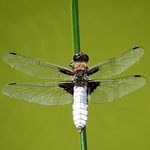Abstract
1 Environmental correlates of broad-scale patterns of Odonata species richness were studied in Europe and part of northern Africa using 220 × 220-km gridded data. Relationships with 11 environmental variables were tested using multiple regression.
2 Two models were constructed: (i) for the entire data set covering both Europe and northern Africa, and (ii) only for Europe.
3 Across both regions, actual evapotranspiration had the strongest relationship with richness, followed by weaker associations of potential evapotranspiration (a concave polynomial) and summer vegetation index (a positive linear relationship). Within Europe the strongest predictor was a concave polynomial of potential evapotranspiration, followed by vascular plant species richness (a positive relationship) and annual precipitation (a concave polynomial).
4 A test of metabolic theory identified strong non-linearity in the temperature-richness relationship, and geographically weighted regression indicated consistency with the theory in a very limited part of Europe.
5 The results are most consistent with the hypothesis that broad-scale species richness patterns are primarily determined by water–energy balance, similar to many fully terrestrial insect groups.
